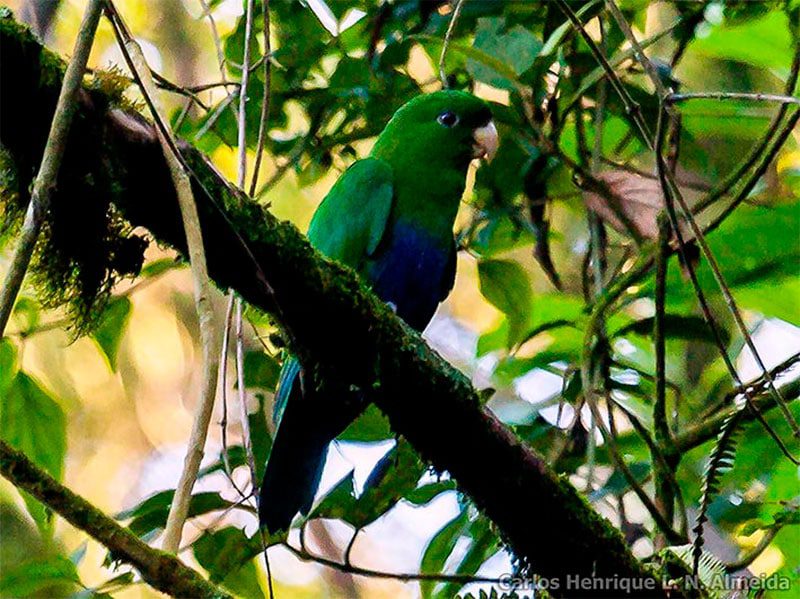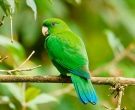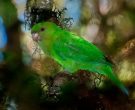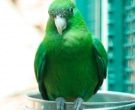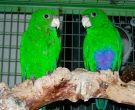Content
|
|---|
Description:
28 cm.. length between 110-155 g. of weight.
The Blue-bellied Parrot (Triclaria malachitacea) has the head, neck and all “upperparts” and wing-coverts, grass-green.
Flight feathers grass-green with narrow blue tips to primaries, except the outermost, with a narrow pale blue margin to outerweb. Under, the wings with coverts green, and flight feather, bluish green. The underparts mainly green with large purplish-blue patch on centre of chest and the belly. Upper, the tail It is green with blue tips to central feathers; undertail, bluish green. Bill pink white: cere Pink; brown the irises; legs grey.
The female lacks the patch in the belly blue violet. The immature is as the adult but the respective young male has less blue purple in the underparts.
- Sound of the Blue-bellied Parrot.
Its singing It is similar to a Thrush (Molothrus).
Habitat:
The Blue-bellied Parrot They live in the humid forests of the low mountains., generally preferring the canopy and the upper floors of tall forest, rich in bromeliads, along watercourses in the valleys. Visit cultivated areas with orchards and plantations and sometimes wooded suburban areas (for example in São Paulo).
Mainly observed at altitudes of 300-700 m, perhaps 1,000 meters in some places, but also they inhabit lowlands at sea level. The sporadic nature of reports, with apparent absence of apparently suitable areas, suggests some critical aspects of its little-understood ecology.
Reproduction:
Observed nests in cavities of large trees or stumps of palm. Strongly territorial, at least during breeding, with separation until nests 2 km. The breeding season It covers the months of September to January, maybe a little earlier or later.
Food:
Its diet it's formed, mainly, by fruit, seeds, outbreaks and nectar, some insects and their larvae (looking birds seen flying insects); specific foods include Pachystroma, Actinostemon, Sebastian, Eugenia, Campomanesia and Euterpe edulis, also occasionally Cortex, and citrus plantations.
Distribution and status:
Size of its range (breeding/resident): 361.000 km2
This rare species is endemic Atlantic forests of Southeast Brazil, mainly in Rio de Janeiro, Sao Paulo and Rio Grande do Sul, in the southeast of Brazil. There are additional records South Bahia (none since 1833), Minas Gerais, Brazil (some dubious records), Holy Spirit (four or five sites), Paraná (three modern records) and Santa Catarina (Mesorregion of the Itajaí Valley, Valle de Tijucas and the region of Serra do Mar, in upstate [Rosario 1996, G. Kohler in some. 2011]).
The species is quite common in large forest fragments in the Itajai Valley (G. Kohler in some ., 2011). Due to changes in habitat in the lowlands Santa Catarina, the most recent records in that state come from montane forests (G. Kohler in some ., 2011). Two records in Missions, Argentina, require confirmation. The population was estimated previously less than 5.000 individuals (Lambert et to the ., 1993), But Bencke (1996) suggested that there may be 10.000 in Rio Grande do Sul and significant numbers on the eastern slope of the Serra do Mar; But, the apparent rarity of the species suggests that these figures may be an overestimation (J. Gilardi in litt., 2010). In general, it is suspected that the population is declining, although in the State Park Tres Picos, Rio de Janeiro, It seems to have been stable since 2003 (A. Foster in a bit).
Population little known due to camouflage habits. Perhaps more numerous in the many facing slopes east of the Serra do Mar in Rio de Janeiro and São Paulo; habitat loss on a large scale has certainly caused a serious decline in its population, as well as the fragmentation of its distribution area. Although humid upland forests remain in substantial quantities in Serra do Mar, replacement of forests in valleys and on lower slopes with banana plantations could lead to further declines.
Captured for local LBMs and traded in small numbers internationally. There are records of several protected areas, but most of them may be insufficient to support populations of this species due to their low density.
Conservation:
• Current category of the Red List of the UICN: Near-threatened.
• Population trend: decreasing.
Rationale for the Red List category
This species is classified as near threatened because they suspect is in a moderately rapid decline due to loss of habitat and, perhaps to a lesser extent, to the capture for trade bird cage.
Justification of the population
The size of the world's population has not been quantified, but this species is generally described as “rare” (Stotz et to the ., 1996), although it is locally common in some places.
Justification of trend
Se sospecha una decrease moderate and continuous of the population depending on rates of habitat loss and perhaps, to a lesser extent, capture for the bird trade. The decline is not thought to be faster because the species occurs in montane areas where deforestation is typically less severe., It seems to tolerate mature secondary forests and anecdotal observations suggest that is locally stable, for example in the State Park Tres Picos, Rio de Janeiro. (A. Foster in a bit ., 2013).
The ecology and conservation of the Blue-bellied Parrot in remaining forest fragments in Rio Grande do Sul
This project aims to collect basic information on population, the distribution and ecology of the Blue-bellied Parrot in the center of Rio Grande do Sul, where a large population of the species is rapidly declining due to habitat fragmentation. The use of the radiotelemetry technique will make it possible to determine the area of use of the species and to evaluate their dispersal capacities.. Biology studies of this species is the objective to determine the elements that make up its diet and collect information on behavior and reproduction.. Through this information, It is intended to outline a regional plan for conservation Blue-bellied Parrot and their habitat, together with local actors. (AU)
Conservation status:
UICN: Vulnerable (with + 2c, d, Cl, Q2a). Previously in danger of extinction (Q2a: see Collar et al., 1994). CITES: Appendix II.
State of national protection: Protected by federal law and included in the list IBAMA of Brazilian species threatened with extinction (Bernardes et al 1990).
"Blue-bellied Parrot" in captivity:
unknown in captivity.
Alternative names:
– Blue-bellied Parrot, Blue bellied Parrot, Purple-bellied Parrot (English).
– Crick à ventre bleu, Caïque à ventre bleu (French).
– Blaubauchpapagei, Blaubauch, Blaubauch-Papagei (German).
– Papagaio-de-peito-roxo, araçoiaba, araçuaiava, cica, sabiá-ci, sabiá-cica (Portuguese).
– Loro de vientre azul, Loro Sabiá-cicá, Loro Ventriazul (español).
– araçoiaba, araçuaiava, cica, sabiá-ci, Sabiá-cica (Brazil).
scientific classification:

– Order: Psittaciformes
– Family: Psittacidae
– Genus: Triclaria
– Scientific name: Triclaria malachitacea
– Citation: (von Spix, 1824)
– Protonimo: Psittacus malachitaceus
Images “Blue-bellied Parrot”:
Videos "Blue-bellied Parrot"
————————————————————————————————
“Blue-bellied Parrot” (Triclaria malachitacea)
Sources:
– Avibase
– Parrots of the World – Forshaw Joseph M
– Parrots A Guide to the Parrots of the World – Tony Juniper & Mike Parr
– Birdlife
– Photos:
(1) – Triclaria malachitacea – Paranapiacaba – Santo André by Carlos Henrique – Flickr
(2) – Blue-bellied Parrot (also known as the Purple-bellied Parrot); two in a cage with a nestbox By TJ Lin [CC BY-SA 2.0], via Wikimedia Commons
(3) – A female Blue-bellied Parrot (also known as Purple-bellied Parrot) at Walsrode Bird Park, Germany By ipfreaks [CC BY-SA 2.0], via Wikimedia Commons
(4) – Rufous-conic (Triclaria malachitacea) – female by Cláudio Dias Timm – Flickr
(5) – Rufous-CICA (Blue-berried Parrot) – Guide to Birds in ePUB by Márcio Duarte – Flickr
(6) – Psittacus cyanogaster or Blue-Bellied Parrakeet by Biodiversity Heritage Library – Flickr
